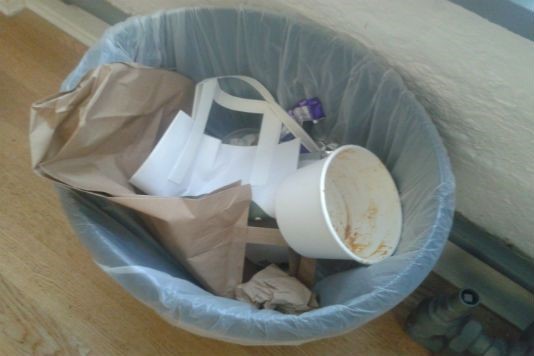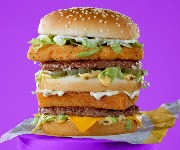Packaging: another part of our food waste problem

Guest writer Marcus Hill on why your lunchtime shop-bought sandwich needn't cost the earth.
When you buy your lunch, do you give much thought to the box that it comes in? Are you more likely to shell out that £3.50 on a sandwich if it’s in a fancy box? And do you ever think about what happens to the box once you’ve had your fill?
Many of us give little conscious thought to the packaging that our lunchtime snack comes in – and this is something I hope will change.
The packaging problem
Every year, over 10 million tonnes of packaging is placed on the UK market (to put this into context, that’s equivalent of around 2.5 million African elephants). In my opinion, the sheer scale of material being produced means that we owe it to the planet to try to understand the processes involved in creating it – and of course what happens to it once we’ve disposed of it.
We’ve come a long way over the past decade or so. Most people I speak to are quick to tell me that they recycle... and this is a great step in the right direction. In fact, around 60% of waste is currently recycled. But when looking at the environmental impact of packaging, it’s just as important to consider the materials used in the packaging, as it is to think about how it’s disposed of.
To continue improving our environmental footprint, we need to start making responsible choices when it comes to what we buy and what we ask of retailers and food businesses.
So how can we reduce the impact that our lunchtime habits have on the environment? Here are my tips.
1. Challenge those using excess packaging
Excess packaging is still a problem, in both supermarkets and sandwich shops. In the UK, regulations state that food and drink packaging ‘must be the minimum amount to maintain necessary levels of safety, hygiene and acceptance for the packed product and for the consumer’. Whilst I don’t think that anyone would argue that safety and hygiene aren’t important, the ‘acceptance’ issue has long been used as an excuse. Often, the use of excess or unsustainable wrapping has been excused as manufacturers argue it’s necessary for ‘product presentation and marketing’. This implies that customers wouldn’t buy the product without it.
One of the easiest ways to make a positive change would be to start encouraging retailers (whatever their size) to reduce the amount of packaging that they use. Ask questions, write letters or simply let your purchasing decisions make the point for you. If we prove that, in fact, the less packaging, the more likely we are to buy, retailers and food manufacturers will quickly start to change their behaviour.
2. Ask ‘what’s it made of?’
Minimising packaging is one thing – but it’s just as important to consider what that sandwich box is actually made of. Look on the pack to see if it contains any recycled material, or if it’s made from a renewable plant based resource (like corn or potatoes). Many food & drink businesses will state this plainly on their packaging. Companies such as Planet Organic, Coca Cola and M&S are great examples of food businesses that are showing a commitment to packaging their products in an environmentally friendly way.
If we all start to make purchasing decisions in favour of packaging made from plants and recycled material this would encourage the food and packaging industry to avoid virgin materials (and the environmental damage they cause).
3. Get to grips with compostable packaging
We all know, on a basic level, what ‘recycled’ means – and most of us are pretty much sold on it. Compostable packaging, however, is currently considered altogether more mysterious.
Put simply, compostable packaging is made from plants, so it’s 100% sustainable. It can break down completely in just 8-12 weeks if disposed of correctly, to leave compost (which can be used for agriculture, which can then help grow the materials needed for future packaging... you get the picture).
4. Dispose responsibly
When you throw things away in a black sack, they go to landfill. Landfill sites are specifically designed to stop things breaking down – so even a lettuce leaf will not decompose for years. And because of our ongoing reliance on landfill, we are rapidly running out of space for landfill sites in the UK. Put in this context, it’s easy to understand why it’s important to think carefully about what happens to packaging waste after use.
Many offices and town centres now have recycling bins aplenty, which makes disposing of your lunch containers a little easier. While it may be a bit of a pain to hold on to your sandwich box until you spot that green bin on the horizon, trust me when I say that little actions like that can make a world of difference.
 Compostable packaging needs to be sent to a composting facility in order to compost quickly and effectively. The best way to ensure this happens is to ask your employer to set up a compostable waste collection (such as the bin pictured right) at your place of work. It is their responsibility, as much as it is yours, to make sure that waste is dealt with in the most environmentally friendly way possible.
Compostable packaging needs to be sent to a composting facility in order to compost quickly and effectively. The best way to ensure this happens is to ask your employer to set up a compostable waste collection (such as the bin pictured right) at your place of work. It is their responsibility, as much as it is yours, to make sure that waste is dealt with in the most environmentally friendly way possible.
Businesses can seek advice from their local councils on setting up a more responsible waste management system. Companies like ours can also put these systems in place to ensure that your organisation is composting or recycling its waste.
What do you think about food packaging? Is there too much? Should we be demanding less? Share your thoughts in the Comments box below.

Marcus Hill is founder and managing director of London Bio Packaging, the original and leading supplier of compostable and recycled packaging to the food and catering industry.
More on cutting down food waste
How a little common sense can help us cut our food waste
How to make the most of leftovers
How to freeze your excess fruit and vegetables
Most Recent
Comments
Be the first to comment
Do you want to comment on this article? You need to be signed in for this feature








